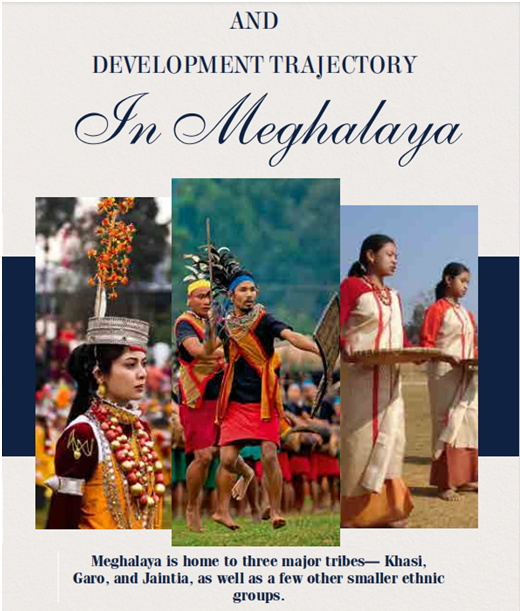
Meghalaya was carved out as a separate state from Assam on January 21, 1972 whereas Mizoram became a Union Territory and Tripura and Manipur were converted from Union Territories to full-fledged states on the same day under the North Eastern Region (Reorganization) Act of 1971. In the turn of 50 years of statehood, the Meghalaya government has been planning to commemorate the year 2022 as the golden jubilee year with great fanfare and enthusiasm. Everyone is looking forward to the celebration. While some are ecstatic about celebrations and the achievements of Meghalaya over the decades, others are skeptical of her progress.
Questions are frequently raised, such as,
· What has Meghalaya accomplished since its statehood that she could not achieve before?
· Are the people of Meghalaya proud of their state’s achievements over the last five decades?
· Has Meghalaya’s overall performance been able to compete with that of the other states born together on January 21, 1972?
· What are the key socioeconomic indicators in which Meghalaya has excelled and where does she lag behind the other states?
 These are some of the issues that need to be addressed closely as Meghalaya prepares to celebrate its statehood and her decades of struggle for the betterment of its citizens. Before we examine Meghalaya’s development trajectory vis-à-vis other two states, namely Mizoram and Tripura that were born together and the nation as a whole, we must first discuss the state’s inception and demographic overview. Due to certain constraints, the fourth state, Manipur, which attained statehood together with the other states, has been excluded from this analysis.
These are some of the issues that need to be addressed closely as Meghalaya prepares to celebrate its statehood and her decades of struggle for the betterment of its citizens. Before we examine Meghalaya’s development trajectory vis-à-vis other two states, namely Mizoram and Tripura that were born together and the nation as a whole, we must first discuss the state’s inception and demographic overview. Due to certain constraints, the fourth state, Manipur, which attained statehood together with the other states, has been excluded from this analysis.
Meghalaya is home to three major tribes— Khasi, Garo, and Jaintia, as well as a few other smaller ethnic groups. The majority of these tribes ruled their own kingdoms until they were annexed one after the other by the British in the nineteenth century. In 1835, the British incorporated these hills into the state of Assam. However, these hill areas were given some autonomy under undivided Assam in the form of Autonomous District Councils (ADCs) in 1970. Following dissatisfaction with the administration of the Assam Government, its imposition of Assamese as an official language, and perceived deprivation of the common people, these ADCs were carved out as a full-fledged Meghalaya state.
The populations of these states roughly increased three folds in the last 50 years (Table 1). Since the 1970s, decadal growth has been extremely rapid, reaching a peak in the 1980s before slowing slightly in the 1990s. If no exact figures were provided, it would be safe to assume that the immigrant populations in these states were significant enough to contribute to population growth, particularly due to illegal migrants from two countries, Bangladesh and Myanmar. Decadal population growth in Meghalaya was 27.6 percent from 2001 to 2011, compared to 22.5 percent and 14.7 percent in Mizoram and Tripura respectively. This population growth has exacerbated the state’s hitherto unsolved development issues in this resource-constrained state with limited revenue-generating capacity.
· SUSTAINABLE DEVELOPMENT GOAL AND HUMAN DEVELOPMENT
The United Nations adopted the Sustainable Development Goals (SDGs), also known as the Global Goals, in 2015 as a universal call to action to end poverty, protect environment, and to ensure peace and prosperity. The SDGs covered 17 key development goals including poverty, education, health, sanitation, infrastructure, energy, environment, etc. Time-bound targets were set for achieving these goals. The SDG index has become the primary tool for monitoring a nation’s progress while also encouraging competition among them. Since 2018, the NITI Aayog in India has been working with the United Nations to bring the SDGs clearly and firmly into the policy framework of the states and UTs. Report of NITI Aayog on SDG Index has grown to become the official and primary tool of the nation for SDG monitoring at the national and sub-national levels. The details of Meghalaya’s scores in comparison to the other two states and the entire nation are taken from the most recent NITI Aayog report on SDG 2020, and are presented in Table 2.
The populations of these states roughly increased three folds in the last 50 years (Table 1). Since the 1970s, decadal growth has been extremely rapid, reaching a peak in the 1980s before slowing slightly in the 1990s. If no exact figures were provided, it would be safe to assume that the immigrant populations in these states were significant enough to contribute to population growth, particularly due to illegal migrants from two countries, Bangladesh and Myanmar. Decadal population growth in Meghalaya was 27.6 percent from 2001 to 2011, compared to 22.5 percent and 14.7 percent in Mizoram and Tripura respectively. This population growth has exacerbated the state’s hitherto unsolved development issues in this resource-constrained state with limited revenue-generating capacity.
· SUSTAINABLE DEVELOPMENT GOAL AND HUMAN DEVELOPMENT
The United Nations adopted the Sustainable Development Goals (SDGs), also known as the Global Goals, in 2015 as a universal call to action to end poverty, protect environment, and to ensure peace and prosperity. The SDGs covered 17 key development goals including poverty, education, health, sanitation, infrastructure, energy, environment, etc. Time-bound targets were set for achieving these goals. The SDG index has become the primary tool for monitoring a nation’s progress while also encouraging competition among them. Since 2018, the NITI Aayog in India has been working with the United Nations to bring the SDGs clearly and firmly into the policy framework of the states and UTs. Report of NITI Aayog on SDG Index has grown to become the official and primary tool of the nation for SDG monitoring at the national and sub-national levels. The details of Meghalaya’s scores in comparison to the other two states and the entire nation are taken from the most recent NITI Aayog report on SDG 2020, and are presented in Table 2.
The populations of these states roughly increased three folds in the last 50 years (Table 1). Since the 1970s, decadal growth has been extremely rapid, reaching a peak in the 1980s before slowing slightly in the 1990s. If no exact figures were provided, it would be safe to assume that the immigrant populations in these states were significant enough to contribute to population growth, particularly due to illegal migrants from two countries, Bangladesh and Myanmar. Decadal population growth in Meghalaya was 27.6 percent from 2001 to 2011, compared to 22.5 percent and 14.7 percent in Mizoram and Tripura respectively. This population growth has exacerbated the state’s hitherto unsolved development issues in this resource-constrained state with limited revenue-generating capacity.
· SUSTAINABLE DEVELOPMENT GOAL AND HUMAN DEVELOPMENT
The United Nations adopted the Sustainable Development Goals (SDGs), also known as the Global Goals, in 2015 as a universal call to action to end poverty, protect environment, and to ensure peace and prosperity. The SDGs covered 17 key development goals including poverty, education, health, sanitation, infrastructure, energy, environment, etc. Time-bound targets were set for achieving these goals. The SDG index has become the primary tool for monitoring a nation’s progress while also encouraging competition among them. Since 2018, the NITI Aayog in India has been working with the United Nations to bring the SDGs clearly and firmly into the policy framework of the states and UTs. Report of NITI Aayog on SDG Index has grown to become the official and primary tool of the nation for SDG monitoring at the national and sub-national levels. The details of Meghalaya’s scores in comparison to the other two states and the entire nation are taken from the most recent NITI Aayog report on SDG 2020, and are presented in Table 2.
The populations of these states roughly increased three folds in the last 50 years (Table 1). Since the 1970s, decadal growth has been extremely rapid, reaching a peak in the 1980s before slowing slightly in the 1990s. If no exact figures were provided, it would be safe to assume that the immigrant populations in these states were significant enough to contribute to population growth, particularly due to illegal migrants from two countries, Bangladesh and Myanmar. Decadal population growth in Meghalaya was 27.6 percent from 2001 to 2011, compared to 22.5 percent and 14.7 percent in Mizoram and Tripura respectively. This population growth has exacerbated the state’s hitherto unsolved development issues in this resource-constrained state with limited revenue-generating capacity.
· SUSTAINABLE DEVELOPMENT GOAL AND HUMAN DEVELOPMENT
The United Nations adopted the Sustainable Development Goals (SDGs), also known as the Global Goals, in 2015 as a universal call to action to end poverty, protect environment, and to ensure peace and prosperity. The SDGs covered 17 key development goals including poverty, education, health, sanitation, infrastructure, energy, environment, etc. Time-bound targets were set for achieving these goals. The SDG index has become the primary tool for monitoring a nation’s progress while also encouraging competition among them. Since 2018, the NITI Aayog in India has been working with the United Nations to bring the SDGs clearly and firmly into the policy framework of the states and UTs. Report of NITI Aayog on SDG Index has grown to become the official and primary tool of the nation for SDG monitoring at the national and sub-national levels. The details of Meghalaya’s scores in comparison to the other two states and the entire nation are taken from the most recent NITI Aayog report on SDG 2020, and are presented in Table 2.
To read the further articles please get your copy of Eastern Panorama January issue @http://www.magzter.com/IN/Hill-Publications/Eastern-Panorama/News/ or mail to contact @easternpanorama.in


